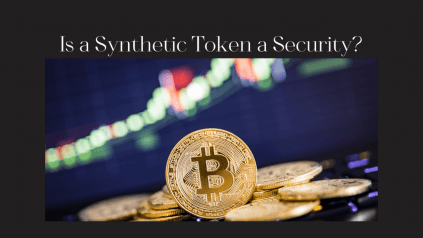IS A SYNTHETIC TOKEN A SECURITY?
INTRODUCTION
It may be easy for someone to generalise a synthetic token as a security or financial product, as, on its face, it does look somewhat like a derivative or financial service. However, this common opinion does not take into consideration how a synthetic actually works, and thus there are often misconceptions as to a synthetic’s legal status.
WHAT IS A SYNTHETIC TOKEN?
To break it down to a foundational level, a synthetic is a token generally created on a blockchain that “references” the value of another asset. By owning a synthetic, you own a token that references the price of an asset – you do not own the asset itself, nor does any related party to the transaction own the asset. What you do own is the collateral used to create the token. A synthetic asset is generally created by over-collateralising another asset (such as ETH) to create the relevant synthetic assets.
A synthetic is generally overcollateralised to account for any volatility shifts of the synthetic asset’s reference price. For example, if the value of ETH is $1000 and a Disney stock is $1000, the protocol may require a 300% overcollateralisation ratio to create that Disney stock synthetic reference. Thus, to create the synthetic that will price reference a Disney stock, 3 ETH [$3000] will be required to be collateralised. However, a person may put in 5 ETH [$5000] to ensure that the synthetic doesn’t get liquidated anytime soon.
Thus, what you are actually trading is the collateralised asset that has been bundled into a token. The issuer of the token is simply choosing what to reference the token price to. It may be a stock such as TESLA, or it could be the current market rate for 1 kilogram of soybeans. It is a price reference point artificially created with collateralisation.
To simplify it even further, a synthetic is similar to a stable coin such as USDC. Each USDC is supposedly collateralised by 1 USD in the bank, thus a 1 to 1 collateralisation. It can be a 1 to 1 collateralisation due to the reference token’s value and the collaterals value being in unison. However, when the collateralisation greatly differs from the reference value such as ETH [collateral] and Tesla stock [reference point], there must be overcollateralisation to allow for volatility shift in (1) the reference value and (2) the collateralisation value.
IS A SYNTHETIC TOKEN A SECURITY?
Broken down into a legal framework, fundamentally, a synthetic is similar to a stable coin as a synthetic token simply creates a new unit of measurement of your collateral. Instead of measuring your ETH in ETH, you are now measuring your ETH in Tesla stock. For example, instead of stating that you will be sending 1 ETH, you will say you’re sending 2 Tesla stock – however, you’re still sending the ETH and not an actual Tesla stock.
Therefore, what an individual is actually trading under Australian law is digital currency measured in a different format than what it has been measured in traditionally. Thus, it would be highly unlikely that a synthetic would be considered a security, financial product, service, or derivative under Australian law. However, this is dependent on each individual synthetic and how it is structured.
NEO LEGAL
Neo Legal are Australian cryptocurrency lawyers. We are highly experienced in matters concerning cryptocurrency, blockchain, and decentralised financing. We don’t simply understand the law: we also understand the technology and mechanics critical in this space. If you require a legal opinion for cryptocurrency or decentralised finance related matters, please reach out. We will generally be able to give an assessment prior to preparing your legal opinion.
DISCLAIMER
This is not a legal opinion and you should not rely on this article as grounds for your project’s legal standing, nor is it an endorsement that all synthetics are not securities. Prior to releasing your product, you should seek a comprehensive legal opinion from a law firm competent in blockchain, cryptocurrency, and decentralised financing.
